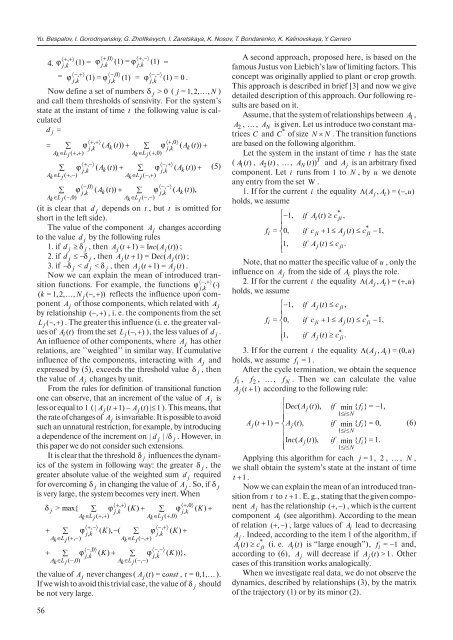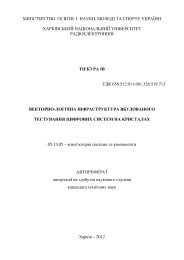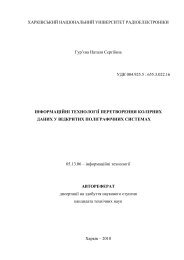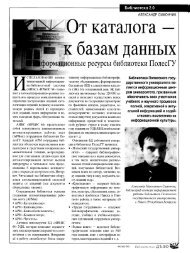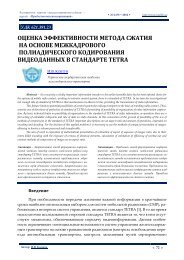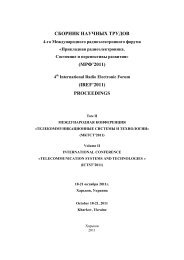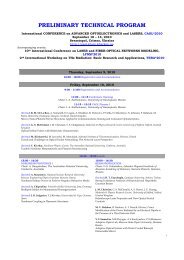информация, язык, интеллект № 3 (77) 2011
информация, язык, интеллект № 3 (77) 2011
информация, язык, интеллект № 3 (77) 2011
You also want an ePaper? Increase the reach of your titles
YUMPU automatically turns print PDFs into web optimized ePapers that Google loves.
Yu. Bespalov, I. Gorodnyanskiy, G. Zholtkevych, I. Zaretskaya, K. Nosov, T. Bondarenko, K. Kalinovskaya, Y. Carrero<br />
56<br />
〈+ , +〉 〈+ ,0 〉 〈+ , −〉<br />
4. ϕ j, k (1) = ϕj, k (1) = ϕj,<br />
k (1) =<br />
= 〈− , +〉 〈− ,0〉<br />
〈−, −〉<br />
ϕj, k (1) = ϕj,<br />
k (1) = ϕ j, k (1) = 0 .<br />
Now define a set of numbers δ j > 0 ( j = 1, 2, … , N )<br />
and call them thresholds of sensivity. for the system’s<br />
state at the instant of time t the following value is calculated<br />
d j =<br />
〈+ , +〉 〈+ ,0〉<br />
= ∑ ϕj, k ( Ak( t)) + ∑ ϕj,<br />
k ( Ak( t))<br />
+<br />
Ak∈ Lj( + , + ) Ak∈ Lj(<br />
+ ,0)<br />
〈+ , −〉 〈− , +〉<br />
∑ ϕj, k ( Ak( t)) + ∑ ϕj,<br />
k ( Ak( t))<br />
+<br />
Ak∈ Lj( + , −) Ak∈Lj( − , + )<br />
(5)<br />
〈− ,0 〉 〈−, −〉<br />
∑ ϕj, k ( Ak( t)) + ∑ ϕj,<br />
k ( Ak( t)),<br />
Ak∈Lj( −,0) Ak∈Lj( −, −)<br />
(it is clear that d j depends on t , but t is omitted for<br />
short in the left side).<br />
The value of the component A j changes according<br />
to the value d j by the following rules<br />
1. if d j ≥ δ j , then Aj( t + 1) = I nc( Aj( t))<br />
;<br />
2. if d j ≤ − δ j , then Aj( t + 1) = D ec( Aj( t))<br />
;<br />
3. if − δ j < d j < δ j , then Aj( t + 1) = Aj( t)<br />
.<br />
Now we can explain the mean of introduced tran-<br />
,<br />
sition functions. for example, the functions ϕ j, k ()<br />
〈− +〉 ⋅<br />
( k = 1, 2, … , Nj( − , + )) reflects the influence upon component<br />
j A of those components, which related with j A<br />
by relationship ( − , + ) , i. e. the components from the set<br />
L j ( − , + ) . The greater this influence (i. e. the greater values<br />
of Ai( t ) from the set L j ( − , + ) ), the less values of d j .<br />
An influence of other components, where A j has other<br />
relations, are ``weighted’’ in similar way. If cumulative<br />
influence of the components, interacting with A j and<br />
expressed by (5), exceeds the threshold value δ j , then<br />
the value of A j changes by unit.<br />
from the rules for definition of transitional function<br />
one can observe, that an increment of the value of A j is<br />
less or equal to 1 ( | Aj( t + 1) − Aj( t)<br />
| ≤ 1 ). This means, that<br />
the rate of changes of A j is invariable. It is possible to avoid<br />
such an unnatural restriction, for example, by introducing<br />
a dependence of the increment on | d j | / δ j . However, in<br />
this paper we do not consider such extensions.<br />
It is clear that the threshold δ j influences the dynamics<br />
of the system in following way: the greater δ j , the<br />
greater absolute value of the weighted sum d j required<br />
for overcoming j δ in changing the value of j A . So, if j δ<br />
is very large, the system becomes very inert. When<br />
〈+ , +〉 〈+ ,0〉<br />
δ j > max{ ∑ ϕj, k ( K) + ∑ ϕj,<br />
k ( K)<br />
+<br />
Ak∈ Lj( + , + ) Ak∈ Lj(<br />
+ ,0)<br />
〈+ , −〉 〈− , +〉<br />
+ ∑ ϕj, k ( K), − ( ∑ ϕj,<br />
k ( K)<br />
+<br />
Ak∈ Lj( + , −) Ak∈Lj( − , + )<br />
〈− ,0 〉 〈−, −〉<br />
+ ∑ ϕj, k ( K) + ∑ ϕj,<br />
k ( K))},<br />
Ak∈Lj( −,0) Ak∈Lj( −, −)<br />
the value of A j never changes ( Aj ( t) = const<br />
, t = 0,1, … ).<br />
If we wish to avoid this trivial case, the value of δ j should<br />
be not very large.<br />
A second approach, proposed here, is based on the<br />
famous Justus von Liebich’s law of limiting factors. This<br />
concept was originally applied to plant or crop growth.<br />
This approach is described in brief [3] and now we give<br />
detailed description of this approach. Our following results<br />
are based on it.<br />
Assume, that the system of relationships between A 1,<br />
A 2 , … , A N is given. Let us introduce two constant ma-<br />
*<br />
trices C and C of size N × N . The transition functions<br />
are based on the following algorithm.<br />
Let the system in the instant of time t has the state<br />
( A1 ( t ) , A2 ( t ) , … , AN( t ))T and A j is an arbitrary fixed<br />
component. Let i runs from 1 to N , by u we denote<br />
any entry from the set W .<br />
1. If for the current i the equality Λ( Aj, Ai) = ( − , u)<br />
holds, we assume<br />
⎧−<br />
*<br />
1, if Ai ( t) ≥ c ji ,<br />
⎪<br />
*<br />
fi = ⎨0,<br />
if c ji + 1 ≤ Aj ( t) ≤ c ji −1,<br />
⎪<br />
⎪1,<br />
if Aj ( t) ≤ c ji.<br />
⎩<br />
Note, that no matter the specific value of u , only the<br />
influence on j A from the side of A i plays the role.<br />
2. If for the current i the equality Λ ( Aj, Ai) = ( + , u)<br />
holds, we assume<br />
⎧−1, if Aj ( t) ≤ c ji ,<br />
⎪<br />
*<br />
fi = ⎨0,<br />
if c ji + 1 ≤ Aj ( t) ≤ c ji −1,<br />
⎪<br />
*<br />
⎪⎩<br />
1, if Aj ( t) ≥ c ji.<br />
3. If for the current i the equality Λ ( Aj, Ai) = (0, u)<br />
holds, we assume f i =1.<br />
After the cycle termination, we obtain the sequence<br />
f 1 , 2 f , … , f N . Then we can calculate the value<br />
Aj( t + 1) according to the following rule:<br />
⎧<br />
⎪D<br />
ec( Aj( t)), if min { fi}<br />
= −1,<br />
1≤i≤N<br />
⎪<br />
Aj( t + 1) = ⎨Aj( t), if min { fi}<br />
= 0, (6)<br />
⎪⎪⎪⎩<br />
1≤i≤N<br />
I nc( Aj( t)), if min { fi}<br />
= 1.<br />
1≤i≤N<br />
Applying this algorithm for each j =1,<br />
2 , … , N ,<br />
we shall obtain the system’s state at the instant of time<br />
t + 1 .<br />
Now we can explain the mean of an introduced transition<br />
from t to t + 1 . E. g., stating that the given component<br />
A j has the relationship ( + , − ) , which is the current<br />
component A i (see algorithm). According to the mean<br />
of relation ( + , − ) , large values of A i lead to decreasing<br />
A j . Indeed, according to the item 1 of the algorithm, if<br />
*<br />
Ai( t) ≥ cji(i.<br />
e. Ai( t ) is “large enough”), fi = − 1 and,<br />
according to (6), A j will decrease if Aj( t ) >1.<br />
Other<br />
cases of this transition works analogically.<br />
When we investigate real data, we do not observe the<br />
dynamics, described by relationships (3), by the matrix<br />
of the trajectory (1) or by its minor (2).


